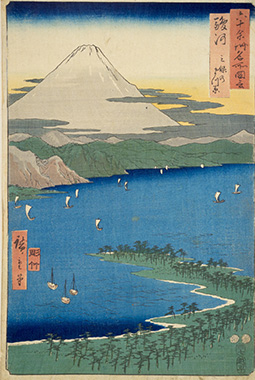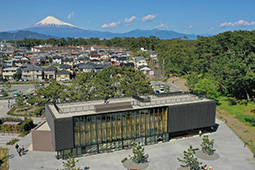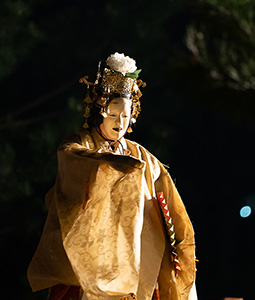January 2023
- English
- 日本語
Miho no Matsubara: Inspiration for Many Works of Art

Miho no Matsubara viewed over the seashore with Mt. Fuji in the background 
The Hagoromo Pine, said to be the tree (the third) where the celestial maiden hung the hagoromo robe

Suruga Miho no Matsubara (Pine Forest at Miho in Suruga Province) from Rokuju-yo Shu Meisho Zue (Famous Places in the Sixty-odd Provinces) by Utagawa Hiroshige (Collection of the National Diet Library) 
Shizuoka City Miho no Matsubara Culture & Creativity Center (Miho Shirube) 
The celestial maiden character as performed by Sakurama Ujin in the noh play Hagoromo

The beautiful scenery of Miho no Matsubara in Shizuoka Prefecture, incorporating the pine forest of the area’s name, the ocean and Mt. Fuji, has been the source of inspiration for many works of art.

Miho no Matsubara is a pine forest on the Miho Peninsula in Shizuoka Prefecture where an estimated 30,000 pine trees stretch along roughly five kilometers of coastline facing the Pacific Ocean. The forest is one of the component assets included on the World Heritage List under the title “Fujisan, sacred place and source of artistic inspiration.”
Pine trees have been regarded as a dwelling place of the deities since ancient times in Japan, partly because the trees remain green even in winter. Miho no Matsubara is considered a sacred place because many pine trees grow there and it affords views of majestic Mt. Fuji, which has been considered a home of the gods and Buddha since ancient times.
“From the beach you can see the pine forest spread out before you with Mt. Fuji in the background. Numerous poems, paintings, and other works of art have been created inspired by such a view,” says Kobayashi Misako of the Shizuoka City Miho no Matsubara Culture & Creativity Center (Miho Shirube). “Miho no Matsubara is about 45 kilometers away from the peak of Mt. Fuji, but the pine forest and mountain are deeply connected in the hearts of Japanese people.”
One of the oldest known works of art featuring Miho no Matsubara as a motif is considered to be a waka poem* from the Man’yoshu, the oldest anthology of Japanese waka, compiled in around the middle of the 8th century. In addition to poetry, there are many paintings that feature this combination of Mt. Fuji and the pine forest on the coast. Among these, the ukiyo-e woodblock prints by artists such as Utagawa Hiroshige (1797–1858) are especially well known.

Hagoromo, a popular play in the traditional performing art of noh** (established in the 14th century) that is based on a legend of the same name, is set in Miho no Matsubara (see box article). In the Hagoromo legend, which has been passed down in various places in Japan since ancient times, a celestial maiden wearing a hagoromo (feathered robe) descends to Earth from Heaven. It is thought that the writer of the noh version of the legend chose Miho no Matsubara as the setting because of its beautiful, sacred scenery.
In Miho no Matsubara, the Hagoromo legend lives on. For example, the Miho Shrine in the forest owns a piece of fabric said to be the torn edge of the fabled feathered robe. A 500-meter-long Kami no Michi (path of the deity) extends in a straight line from the shrine to the beach, and is said to be used by visiting deities. The path is surrounded by pine trees estimated to be between 200 and 300 years old, and among them the mighty 15-meter-tall Hagoromo Pine on the beach is said to serve as a landmark for deities descending to earth.
Near the Hagoromo Pine is the aforementioned Miho Shirube, where visitors can learn about the culture and history of Miho no Matsubara, as well as the importance of its preservation. Large pine root specimens are on display along with paintings and other works of art, and beautiful videos introducing Miho no Matsubara and Mt. Fuji. From the building’s roof, Mt. Fuji is clearly visible above the pine forest.
“I like Mt. Fuji without any snow, the so-called ao-fuji (blue Fuji), but of course the sight of the mountain with its peak covered in snow from January through March is truly amazing,” says Kobayashi. “I hope that many people can learn here about the history and beauty of Miho no Matsubara, which Japanese people have loved since ancient times and which has been the source of inspiration for so many works of art.”
- * Refers to Man’yoshu, volume 3, 296, composed by Taguchi no Masuhito: Ihohara no kiyomi no saki no miho no ura no yutakeki mitsutsu mono omoimo nashi (“Looking upon the rich sea of Miho no Ura, gone is my anxiety of traveling to a new post”)
- For waka poetry, see Highlighting Japan June 2021, “Ceremony of the Utakai Hajime” https://www.gov-online.go.jp/eng/publicity/book/hlj/html/202106/202106_09_en.html
- ** See Highlighting Japan December 2021, “A Noh Actor Discovers that “Art Knows No Borders”” https://www.gov-online.go.jp/eng/publicity/book/hlj/html/202112/202112_12_en.html
Synopsis of the Noh Play Hagoromo


Fisherman Hakuryo discovers a hagoromo (feathered robe) hanging on a pine branch in Miho no Matsubara and tries to take it home with him. As he does so, a celestial maiden appears and asks him to return the hagoromo. When he refuses, she begins to cry and laments that she cannot return to Heaven without it. Pitying the maiden, Hakuryo agrees to return the hagoromo if the maiden will only perform her dance for him. As she puts on the hagoromo and begins to dance, she soars above Mt. Fuji and disappears into Heaven.

